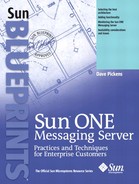High Availability—Failover Architecture
One of the easiest and simplest ways of architecting a high-availability configuration is to cluster, using the Sun™ Cluster 3.0 software for example (FIGURE 3-5).
Figure 3-5. Simple Failover Configuration

This architecture provides a highly available yet simple configuration. As you would expect, the benefits and drawbacks of this architecture closely mirror those of the simple configuration, with the exception being it is now highly available.
The clustering software not only handles hardware failures but in may cases, software issues as well, trying to restart failed daemons or processes first, then triggering a complete restart or failover of the entire system.
Failover itself can vary between minutes to as much as an hour depending upon the specific configuration, settings, and storage status. Should a catastrophic storage failure occur, parity and sanity checks on the storage subsystem can add significant to the normally fast (that is, less than 10 minutes) failover time.
A more complex high availability configuration (FIGURE 3-6) combines the portions of the secure architecture with that of the simple failover.
Figure 3-6. Failover With Relays and Firewall

By combining the failover of the secure configuration with parts of the simple failover, you can obtain availability for the routing (MTA), access (proxy), and mailstore, yet have the ability to extend services such as web mail, IMAP, and POP access to users external to the internal network.
One aspect of availability that will be addressed further in Chapter 14, “Highly Available Messaging Deployment,” on page 201,” is Directory Server availability. Currently there are two models for providing availability of LDAP (directory) services—the traditional failover using Sun Cluster or VERITAS products and the Multiple Master Replication feature of the Sun ONE Directory Server. Each has its own benefits and drawbacks, with many people looking at Multiple Master Replication as the new defacto method for addressing availability of the directory server.
Sun has a Reference Architecture program that defines the hardware and software components needed to build end-to-end solutions that meet specific business needs. Each Reference Architecture has been designed, tested, and documented, so users can reduce the complexity, costs, and risks of deploying new technology in their enterprises. Sun's Reference Architectures combine:
A documented multitiered architecture
Recommended technology products from Sun and other vendors
Architecture, sizing, and implementation guides
For more details on the Messaging Reference Architecture, see:
http://www.sun.com/products/architectures-platforms/refarch/specs.html#g1_5.1.
